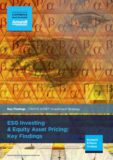With the rising awareness around ESG issues worldwide, institutional investors have started to massively look into responsible investment. The latter has grown substantially in Europe and in North America in the past 5 years. Amundi’s new research on the impact of ESG investing on equity asset pricing finds that when an alpha strategy is massively implemented, it becomes a beta strategy.
In Europe, the massive mobilization of institutional investors regarding ESG investing has impacted demand mechanisms, with a subsequent effect on prices, thereby also triggering a performance premium.
KEY FINDINGS
The study focused on the period 2010-2017 and used Amundi’s proprietary ESG scores and Environmental, Social and Governance (E,S and G) sub-components to screen portfolios. The analysis was conducted for passive, active and multi-factor portfolios for Europe and North America, among others.
Return profile
|
1
|
|
Between 2010-2013, being a responsible investor would have tended to penalize both active and passive European and North American portfolios. Between 2010-2013 only Environmental-focused passive investors in the Eurozone would have enjoyed outperformance, while effects of Governance-focused and Social-focused portfolios on performance were neutral or negative.
|
2
|
|
From 2014-2017, responsible investing was generally a source of outperformance in the Eurozone and North America. In the Eurozone, all pillars (Environmental, Social and Governance) and ESG score integration displayed positive returns, with the Governance pillar dominating. In North America, ESG investing during the 2014-2017 period also displayed positive returns, although the Environmental component is the largest winner.
|
3
|
|
Our study identifies several performance generation mechanisms, demonstrating that stock prices integrate ESG-related information at different levels. These mechanisms are dependent on the geographic region studied, the ESG focus, the ranking (best / worst-ranking or all gradients) and the period studied.
Overall, in North America between 2014-2017
(i) ESG-portfolios’ excess return increased with the ESG score;
(ii) only best-in-class stocks were remunerated for Environmental-focused portfolios, and only since 2016 for Social-focused portfolios;(iii) and only worst-in-class stocks were penalized for Governance-focus portfolios.
Similarly, in the Eurozone between 2014-2017
(i) both best-in-class stocks were remunerated and worst-in-class stocks were penalized for ESG -and Governance- focused portfolios, and only since 2016 for Social-focused portfolios;
(ii) and only best-in-class stocks were remunerated for Environmental-focused portfolios.
Figure 1 – Overview of performance generation mechanisms per region and observation period
All-in-all, the best-in-class stocks have been consistently remunerated in Environmental-focused portfolios across North America and the Eurozone between 2014-2017.
|
Diversification profile
|
4
|
|
ESG-induced performance improvements must be implemented carefully: there is a tipping point beyond which ESG score improvements reduce the investment universe and hence, can negatively impact diversification and performance. When improving the ESG score of a portfolio, the investment universe is reduced which can lead to a reduction of the diversification if the constraint is too strong.
|
5
|
|
Responsible investing has become a beta strategy in Eurozone (as ESG is a risk factor), but remains an alpha strategy in North America (as ESG is not a risk factor). Introducing ESG as a factor into a multi-factor approach of portfolio construction adds value by improving the diversification in the Eurozone, but not in North America.
|
Risk profile
|
6
|
|
ESG screening does not necessarily improve drawdown management. ESG screening did not significantly reduce the maximum drawdown of portfolios for both the 2010-2013 and 2014-2017 periods.
|
7
|
|
To seize the benefits of ESG investing for the portfolio profile, passive investors need to accept additional, yet controlled, tracking error compared with capitalization-weighted benchmarks. Beyond accepting additional – yet controlled – tracking error, combining ESG with passive investment may imply the need to design ESG-based Strategic Asset Allocation
|
|
More information/download the reports





